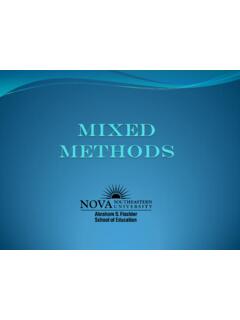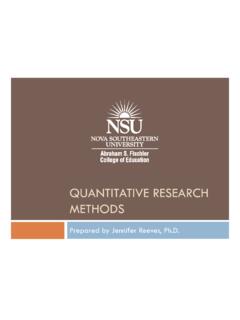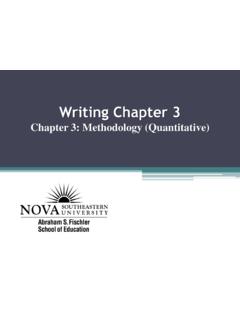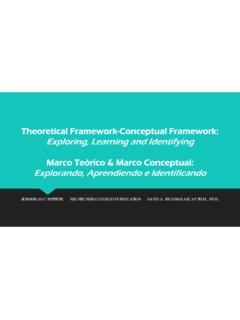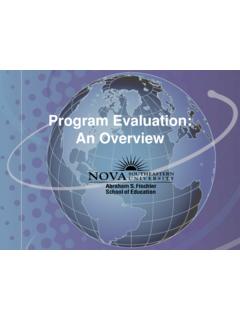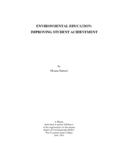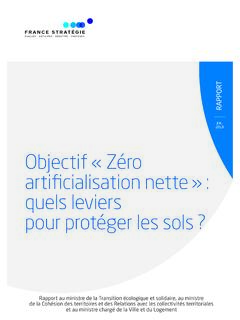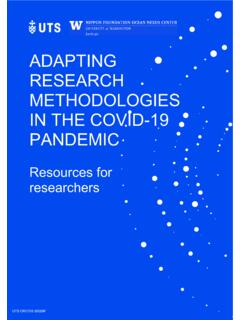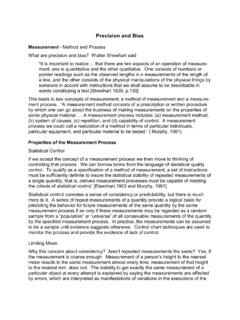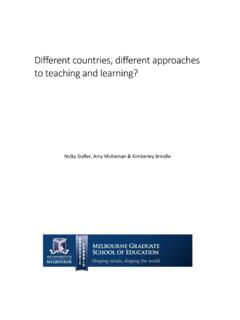Transcription of Quantitative Research Methods - Nova Southeastern University
1 Quantitative Research MethodsFSEHS-ARCO verview Research Process Quantitative Methods Designs Validity and Research DesignsA Definition of ResearchResearch is a process of steps used to collect and analyze information in order to increase our understanding of a topic or With Research Today Contradictory or vague findings Questionable data Unclear statements about the intent of the study Lack of full disclosure of the data-collection procedure Inarticulate rendering of the Research problemThe Process of Research Identify theResearch ProblemReview theLiteratureReportandEvaluate ResearchSpecify a Research PurposeCollect DataAnalyze andInterpretDataThe Process of Research : Identify the Research Problem Specify a problem Justify a problem Suggest a need to study the problem for audiencesThe Process of Research : Review the Literature Locate resources Books Journals Electronic resources Select resources Determine the relevant resources for the topic Organize the resources by developing a Literature Map Summarize the resources in a literature reviewThe Process of Research .
2 Specify a Research Purpose Identify the purpose statement The major intent of the study The participants in the study The site of the study Narrow the purpose statement Quantitative : Write Research questions and/or hypothesis qualitative : Identify a central phenomenon and write subquestionsThe Research Process: Collect Data Determine the data-collection method Select the individuals to study Design or select data-collection instruments and outline data-collection procedures Obtain permissions Gather dataThe Research Process: Analyze and Interpret Data Take the data apart to look at individual responses Represent the data in tables, figures, and pictures Explain conclusions from the data that address the Research questionsEthical Considerations in Research Respect the rights of the participants Honor the requests and restrictions of the Research site Report the Research fully and honestlyDefinitions of Quantitative and qualitative ResearchQuantitative ResearchA type of educational Research in which the researcher decides what to study; asks specific, narrow questions.
3 Collects quantifiable data from participants; analyzes these numbers using statistics; and conducts the inquiry in an unbiased, objective manner. Characteristics of Quantitative Research An emphasis on collecting and analyzing information in the form of numbers An emphasis on collecting scores that measure distinct attributes of individuals and organizations An emphasis on the procedures of comparing groups or relating factors about individuals or groups in experiments, correlational studies, and surveys Characteristics of Quantitative Methods in the Process of ResearchSteps in the Research ProcessQuantitative Characteristics Standard and Fixed Objective and UnbiasedAnalyze and Interpret DataReport and EvaluateCollect DataSpecify a PurposeReview the LiteratureIdentify a Problem Descriptive/Explanatory Major Role Justify Problem Specific and Narrow Measurable/Observable Predetermined instruments Numeric Data Large Numbers Statistical Description of Trends Comparisons/PredictionsQuantitative MethodsExperimental Research : Between-Subjects Approach NonexperimentalResearch.
4 CorrelationalApproachNonexperimentalRese arch:Survey ApproachExplaining whether anintervention influencesan outcome for onegroup as opposed to another groupAssociating orrelating variablesin a predictablepattern for onegroup of individualsDescribing trends forthe population ofpeopleInterventionResearchNonintervent ionResearchMethod, Research , Approach and Design(Edmonds & Kennedy, 2012)Edmonds, W. A., & Kennedy, T. D. (2012). An applied reference guide to Research designs: Quantitative , qualitative , and mixed Methods . Thousand Oaks, CA: methodis the theoretical, philosophical, and data analytic perspective. The method can be Quantitative , qualitative , or mixed ( , a Quantitative method1).
5 RESEARCH2 Researchrefers to the systematic process of group assignment, selection, and data collection techniques. Research can be experimental, quasi-experimental, or non-experimental ( , a Quantitative method1and experimental research2). APPROACH3 The approachis the first step to creating structure to the design, and it details (a) a theoretical model of how the data will be collected, and (b) if one case, one group, or multiple groups will be associated with the process ( , a Quantitative method1, experimental research2with a between-subjects approach3). DESIGN4 The designis the actual structure or framework that indicates (a) the time frame(s) in which data will be collected or how and when the data will be analyzed using qualitative Methods , (b) when the treatment will be implemented (or not), and (c) the exact number of groups that will be involved ( , a Quantitative method1, experimental research2with a between-subjects approach3and a pre-and posttest control group design4).
6 Experimental Research utilizing a between-subjects approach with a pre-and posttest control group designChao, P., Bryan, T., Burstein, K., & Ergul, C. (2006). Family-centered intervention for young children at-risk for language and behavior problems. Early Childhood Education Journal, 34(2), (n= 22)TELD-3, ECBIF amily-Centered InterventionTELD-3, ECBIR2 (n= 19)TELD-3, ECBI-TELD-3, ECBITime Research Question:Does active parent engagement in selecting and using routine-based activities have a positive effect on children's language and appropriate behavior development?Nonexperimentalresearch utilizing a correlationalapproachwith an explanatory design Walker, C.
7 O., & Greene, B. A. (2009). The relations between students motivational beliefs and cognitive engagement in high school. Journal of Educational Research , 102(6) : What classroom motivation variables are related to students sense of belonging?VariablesStudents (n= 249)MotivationSelf, efficacy, instrumentality, goalsSense of belongingSense of belonging surveyNonexperimentalresearch utilizing a survey approach with a cross-sectional designJones, M. A., Stratten, G., Reilly, T., & Unnithan, V. B. (2004). A school-based survey of recurrent non-specific low-back pain prevalence and consequences in children. Health Education Research , 19(3), Question:What evidence exists to demonstrate the prevalence and consequences of recurrent low-back pain in children?
8 Variable (N= 500)Time point 1 Low-back painLow-back pain surveyThreats to Internal Validity (examples) ThreatExplanationHistoryAny event that occurs during the time of the treatment and the posttest that could affect the outcome ( , natural life events such as a death in the family, change in job, or moving).MaturationThe natural process of changing, growing, and learning over effects of practice familiarity in taking the same test more than once ( , the participant who takes the same math achievement test twice in the pre-and posttest measures may improve performance simply because of the familiarity with the test)InstrumentationThe change in a measuring instrument over time ( , some instruments undergo revisions).
9 Edmonds, W. A., & Kennedy, T. D. (2010). A reference guide to basic Research design for education and the social and behavioral sciences. New York, NY: to External Validity (examples)Edmonds, W. A., & Kennedy, T. D. (2010). A reference guide to basic Research design for education and the social and behavioral sciences. New York, NY: CharacteristicsThe extent to which the sample ( , unit) represents the population from which it is drawn ( , for a sample to represent a population, the researcher must employ the appropriate sampling procedures and perform random selection).Stimulus Characteristics and SettingsThe unique factors involved in providing the treatment or intervention, such as the setting and researchers ( , it is difficult to replicate contrived laboratory conditions to real-life scenarios).
10 Treatment VariationsVariations in the same treatment or the combination of multiple or partial treatments account for different VariationsObserving the effect of one type of outcome differs when alternate outcomes are MediationMediating variables related to outcomes differ between contexts or to Construct Validity (examples)Edmonds, W. A., & Kennedy, T. D. (2010). A reference guide to basic Research design for education and the social and behavioral sciences. New York, NY: and Contact with ParticipantsSimilar to special treatment, the level of attention, or differentiated attention, between the groups from the experimenter ( , the researcher spends more time with Group 1 than Group 2, and the differences observed in the outcome can be explained by the increased amount of attention and not due to the intervention).
